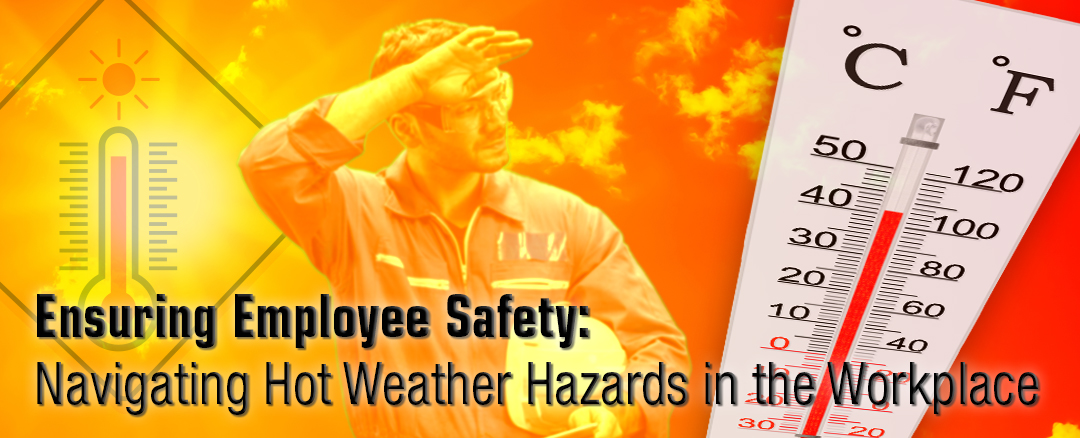Ensuring Employee Safety: Navigating Hot Weather Hazards in the Workplace

As the sun blazes down during the scorching summer months, the importance of prioritizing the safety and well-being of your staff in hot weather conditions cannot be overstated. Rising temperatures can pose significant risks to employees, leading to heat-related illnesses and discomfort that can undermine productivity and even endanger lives. However, with appropriate measures and increased awareness, employers can create a safe working environment that protects their workforce and ensures optimal performance.
Understanding the Risks
Heat-related illnesses are a serious concern when employees are exposed to high temperatures for prolonged periods. From heat rash and cramps to more severe conditions like heat exhaustion and heatstroke, these health issues can escalate quickly and have dire consequences. Moreover, reduced concentration, fatigue, and impaired decision-making due to heat stress can compromise job performance and increase the likelihood of accidents.

Implementing Appropriate Measures
Creating a safe working environment in hot weather conditions requires a multi-faceted approach that combines proactive measures and comprehensive policies. Here are some key strategies to consider:
- Hydration: Adequate hydration is the cornerstone of heat safety. Employers should provide easy access to clean, cool drinking water and encourage employees to stay hydrated throughout the day. Regular breaks for water consumption can be integrated into work schedules to ensure employees are replenishing lost fluids.
- Break Scheduling: Introducing frequent rest breaks in shaded or air-conditioned areas allows employees to cool down and recharge. These breaks can also help prevent the onset of heat-related illnesses by giving workers a chance to recover from heat stress.
- Adjusting Workloads: When feasible, employers should consider rescheduling physically demanding tasks to cooler parts of the day. Heavy labor during the hottest hours should be avoided or minimized, and workloads should be adjusted to account for the heat.
- Protective Gear: If job requirements necessitate the use of personal protective equipment (PPE), efforts should be made to select lightweight, breathable options that minimize heat retention. Employers should also ensure that employees are trained in the proper use and care of PPE.
- Heat Awareness Training: Comprehensive training on recognizing the symptoms of heat-related illnesses is vital. Employees should be educated about the early signs of heat exhaustion and heatstroke, empowering them to take appropriate action promptly.
- Well-Ventilated Workspaces: If possible, workspaces should be equipped with proper ventilation systems or air conditioning to maintain a comfortable temperature. Natural airflow and strategically placed fans can also help in creating a more breathable environment.
Promoting Awareness
Promoting awareness about the risks of working in hot weather conditions is a critical component of safeguarding employee well-being. Here’s how employers can enhance awareness:
- Educational Materials: Distribute informative pamphlets, posters, or digital resources that highlight the importance of heat safety. These materials can cover topics such as the dangers of heat-related illnesses, preventive measures, and the significance of early intervention.
- Regular Communication: Use team meetings, email newsletters, or bulletin boards to regularly remind employees about heat safety practices and the available resources for staying cool and hydrated.
- Lead by Example: Management should set the tone by adhering to safety protocols themselves. When employees see their supervisors taking heat safety seriously, they are more likely to follow suit.
- Open Dialogue: Encourage open communication between management and employees. Workers should feel comfortable reporting any discomfort or symptoms they experience due to heat stress, so that appropriate actions can be taken promptly.
- Flexible Policies: Consider implementing flexible work arrangements during extreme heat conditions. This could involve adjusted work hours, remote work options, or additional breaks to allow employees to adapt to the weather more effectively.

By implementing appropriate measures and promoting awareness, workplaces can mitigate the risks associated with heat-related illnesses, creating a safer and more productive environment. Remember, a well-informed and well-prepared workforce is the foundation of a resilient and successful organization, even in the face of the hottest summer days.




Leave a Comment
You must Register or Login to post a comment.